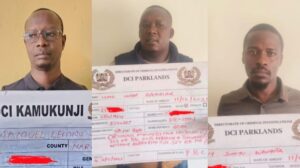Immigration fraud has long been a hidden problem in the United States, but this past week authorities brought it into sharper focus through a major enforcement drive in Minneapolis–St. Paul.
The United States Citizenship and Immigration Services, working together with Immigration and Customs Enforcement and the Federal Bureau of Investigation, carried out an operation called Twin Shield between September 19 and 28.
This was one of the largest initiatives of its kind in a single city, targeting 1,000 flagged immigration benefit applications.
Officials conducted more than 900 site visits and interviews, and what they uncovered was troubling. Nearly half of the cases reviewed, about 275 in total, were found to involve fraud, ineligibility, or potential risks to national security and public safety.
Among the cases revealed, one stood out not only for its boldness but also for what it symbolized about weak systems of documentation.
A Kenyan man admitted that he had bought a fake death certificate for just 100 dollars to dissolve a marriage that was still very much alive.
The woman he claimed to have buried is living in Minneapolis and is raising five of his children. For investigators, this became a clear example of how cheaply fraud can be carried out and how easily falsified documents can enter a foreign immigration system.
The operation also revealed other cases ranging from arranged sham marriages intended to secure green cards, to exploitation of elderly Americans through forced unions, and even the exposure of individuals connected to security risks.
In one case, a woman who had sworn under oath that her marriage was genuine admitted only hours later that it was fraudulent.
Another case involved the son of a suspected terrorist who had overstayed his visa despite repeated application denials for fraud.
Joseph B. Edlow, the USCIS Director, said this operation marked a turning point for the agency. He explained that under the Trump administration, immigration officers were directed to pursue fraud with greater intensity than ever before.
He described the effort as an “all-out war on immigration fraud,” stressing that such acts not only undermine the law but also harm those who pursue legal paths to residency and citizenship.
Already, 42 cases have been referred for court proceedings or handed to ICE, with four arrests made on-site. Officials expect the numbers to grow as more cases are finalized.
The Kenyan case, however, carried an extra dimension that reached beyond U.S. borders. Kenyan community leaders abroad expressed concern that many of those implicated in fraud are not native-born Kenyans but individuals, often from Somalia, who managed to acquire Kenyan identification documents through weak or corrupt registration systems.
With these papers, they are able to travel abroad as Kenyans, and when they are caught in fraud schemes, Kenya’s name is the one tied to the scandal.
This trend has sparked frustration among Kenyans in the diaspora who work hard to maintain a good reputation. They fear being judged or profiled because of fraudulent actions linked to people who have little real connection to Kenya but misuse its documents for personal gain.
Analysts argue that the fabricated death certificate in Minneapolis is a striking reminder of how dangerous weak documentation systems can be. It shows how easily a fraudulent Kenyan paper can affect legal proceedings in a foreign country and how such incidents damage the image of Kenya internationally.
There is now growing pressure on Kenya to tighten the way it issues national identity cards, passports, and citizenship rights. Without stronger checks, fraudsters will continue to exploit gaps in the system, and Kenya’s reputation abroad will remain at risk whenever another scandal surfaces.





















Add Comment